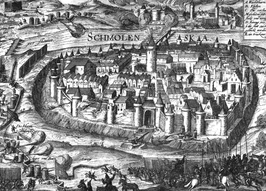Siege of Smolensk (1609–11)
| Siege of Smolensk | |||||||
|---|---|---|---|---|---|---|---|
| Part of Polish–Muscovite War (1605–18) | |||||||
 |
|||||||
|
|||||||
| Belligerents | |||||||
|
|
|
||||||
| Commanders and leaders | |||||||
| King Sigismund III | Mikhail Borisovich Shein | ||||||
| Strength | |||||||
| 22,000 soldiers 30 heavy guns |
5,000 soldiers 200 heavy guns |
||||||
| Casualties and losses | |||||||
| Unknown | Unknown | ||||||
The Siege of Smolensk, known as the Smolensk Defense in Russia (Смоленская оборона in Russian) lasted 20 months between September 1609 and June 1611, when the Polish army besieged the Russian city of Smolensk during the Polish–Muscovite War (1605–18).
In September 1609, the Polish army under the command of King Sigismund III Vasa (22,000 men: 12,000 Polish soldiers and 10,000 Ukrainian Cossacks; 30 guns) approached Smolensk. The city was defended by the Russian garrison under the command of voyevoda Mikhail Borisovich Shein (over 5,000 men and 200 guns). On 25–27 September, the invaders assaulted Smolensk for the first time with no result. Between 28 September and 4 October, the Poles were shelling the city and then decided to lay siege to it. On 19–20 July, 11 August, and 21 September, the Polish army attacked Smolensk for the second, third, and fourth time, but to no avail. The siege, the shelling, and the assaults alternated with fruitless attempts of the Polish army to persuade the citizens of Smolensk to capitulate. Negotiations in September 1610 and March 1611 did not lead anywhere.
The largest mining project at Smolensk came in December 1610; however, the Poles only managed to destroy a large portion of the outer wall, the inner walls remaining intact. The siege continued. At one point, the Polish guns breached the outer wall and the voivode of Bracław ordered his soldiers to rush in; however, the Russians could see where the breach would come and had fortified that part of the wall with more people. Both sides were slaughtered, and the Poles were eventually beaten back.
The citizens of Smolensk had been coping with starvation and epidemic since the summer of 1610. The weakened Russian garrison (with only about 200 remaining soldiers) was not able to repel the fifth attack of the Polish army on 3 June 1611, when after the 20 months of siege the Polish army advised by the runaway traitor Andrei Dedishin, discovered a weakness in the fortress defence and on 13 June 1611 a Cavalier of Malta, Bartłomiej Nowodworski, inserted a mine into a sewer canal and the succeeding explosion created a large breach in the fortress walls. Jakub Potocki was the first on the walls. The fortress fell on the same day, with the last stage taking place after violent street fighting, when some 3,000 Russians citizens blew themselves up in the Assumption Cathedral. Wounded Mikhail Shein was taken prisoner and would remain a prisoner of Poland for the next 9 years.
...
Wikipedia
